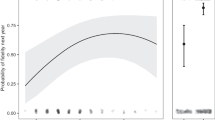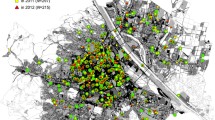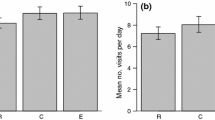Abstract
In northern Sweden breeding males of Tengmalm's owls (Aegolius funereus (L.)) were site tenacious during and between the peaks of the vole (staple food) cycles, but females only during the peaks. Most of these adults shifted nest boxes between successive years. They selected nest boxes randomly in a radius of 3 km. Juveniles, in contrast to site tenacious adults, dispersed outside their natal area. The females moved longer than the males prior to their first breeding. Five adult females were found to be nomadic. One of these nomadic females previously bred site tenaciously as long as food was abundant. Juveniles and adult males were not found to be nomadic. Emigration of adult females and juveniles occurred most frequently when vole populations declined. The breeding population increased sharply and received immigrants suggesting that nomadism may be essential in the population dynamics. Site tenacity and nomadism are discussed in terms of costbenefit to males and females, respectively. Emphasis is on the main functional roles of males (feeding femle and young) and females (incubation).
Similar content being viewed by others
References
Ahti T, Hämet-Ahti L, Jalas J (1968) Vegetation zones and their sections in northwestern Europe. Ann Botan Fennici 5:169–211
Andersson M (1980) Nomadism and site tenacity as alternative reproductive tactics in birds. J Anim Ecol 49:175–184
Gauthreaux SA Jr (1982) The ecology and evolution of avian migration systems. Avian biology vol VI:93–167
Glutz von Blotzheim UN, Bauer KM (1980) Handbuch der Vögel Mitteleuropas. Vol 9 — Akademische Verlagsgesellschaft. Wiesbaden
Greenwood PJ (1980) Mating systems, philopatry and dispersal in birds and mammals. Anim Behav 28:1140–1162
Greenwood PJ, Harvey PH (1982) The natal and breeding dispersal of birds. Ann Rev Ecol Syst 13:1–21
Haartman L von (1968) The evolution of resident versus migratory habit in birds. Some considerations. Ornis Fenn 45:1–7
Hansson L (1979) Food as a limiting factor for small rodent numbers: tests of two hypotheses. Oecologia (Berlin) 37:297–314
Haase W, Schelper W (1972) Zweitbruten als Schachtelbruten beim Rauhfusskauz. Vogelkundl Ber Niedersachsen 4:65–68
Holmberg T (1980) Polygyny in Tengmalm's owl, Aegolius funereus. Vår Fågelv 39:405 (In Swedish with English summary)
Holmberg T (1982) Breeding density and site tenacity of Tengmalm's owl, Aegolius funereus Vår Fågelv 41:265–267 (In Swedish with English summary)
Hörnfeldt B (1978) Synchronous population fluctuations in voles, small game, owls and tularemia in northern Sweden. Oecologia (Berlin) 32:141–152
Hörnfeldt B, Löfgren O, Carlsson B-G (1986) Cycles in voles and small game in relation to variations in plant production indices in northern Sweden. (Oecologia in press)
Källander H (1964) Irruption in 1958 of Tengmalm's owl (Aegolius funereus) into Central Sweden and some aspects on the distribution of the species in Sweden. Vår Fågelv 23:119–135
Kellomäki E, Heinonen E, Tiainen H (1977) Two successful nestings of Tengmalm's owl in one summer. Ornis Fenn 54:134–135 (In Finnish with English summary)
König C (1969) Sechsjährige Untersuchungen an einer Population des Rauhfusskauzes, Aegolius funereus (L.). J Ornithologie 110:133–147
Kondratzki B, Altmüller R (1976) Bigynie beim Rauhfusskauz (Aegolius funereus). Vogelwelt 97:146–149
Korpimäki E (1981) On the ecology and biology of Tengmalm's owl (Aegolius funereus). Acta Universitatis Ouluensis Series A. Scientiae Rerum Naturalium No 118. Biologica No 13
Korpimäki E, Lagerström M, Saurola P (1986) Field evidence for nomadism in Tengmalm's owl Aegolius funereus. Ornis Scand (in press)
Lagerström M, Syrjänen J (1973) Helmipöllökoiraiden pyyntilaite (A trap for males of Tengmalm's owl). Ringmärkningsbyråns meddelanden No 54, p 3 (In Finnish)
Lundberg A (1979) Residency, migration and a compromise: adaptations to nest-site scarcity and food specialization in three Fennoscandian owl species. Oecologia, (Berlin) 41:273–281
Myllymäki A, Christiansen E, Hansson L (1977) Five year surveillance of small mammal abundance in Scandinavia. EPPO Bull 7:385–396
Mysterud I (1970) Hypothesis concerning characteristics and causes of population movements in Tengmalm's Owl (Aegolius funereus (L.)) Nytt Mag Zool 18:49–74
Newton I, Marquiss M (1983) Dispersal of sparrowhawks between birthplace and breeding place. J Anim Ecol 52:463–477
Norberg Å (1964) Studies on the ecology and ethology of Tengmalm's owl (Aegolius funereus) Vår Fågelv 23:228–244 (In Swedish with English summary)
Schwerdtfeger O (1984) Verhalten und Populationsdynamik des Rauhfusskauzes (Aegolius funereus). Die Vogelwarte 32:183–200
Solheim R (1983) Bigyny and biandry in the Tengmalm's owl Aegolius funereus. Ornis Scand 14:51–57
Sonerud GA (1985) Nest hole shift in Tengmalm's owl Aegolius funereus as a defence against nest predation involving longterm memory in the predator. J Anim Ecol 54:179–192
Sulkava P, Sulkava S (1971) Die nistzeitliche Nahrung des Rauhfusskauzes (Aegolius funereus) in Finnland 1958–67. Ornis Fenn 48:117–124
Ulfstrand S, Högstedt G (1976) Hur måga fåglar häckar i Sverige? (How many birds breed in Sweden?). Anser 15:1–32 (In Swedish with English summary)
Wallin K, Andersson M (1981) Adult nomadism in Tengmalm's owl Aegolius funereus. Ornis Scand 12:125–126
Author information
Authors and Affiliations
Rights and permissions
About this article
Cite this article
Löfgren, O., Hörnfeldt, B. & Carlsson, B.G. Site tenacity and nomadism in Tengmalm's owl (Aegolius funereus (L.)) in relation to cyclic food production. Oecologia 69, 321–326 (1986). https://doi.org/10.1007/BF00377051
Received:
Issue Date:
DOI: https://doi.org/10.1007/BF00377051




